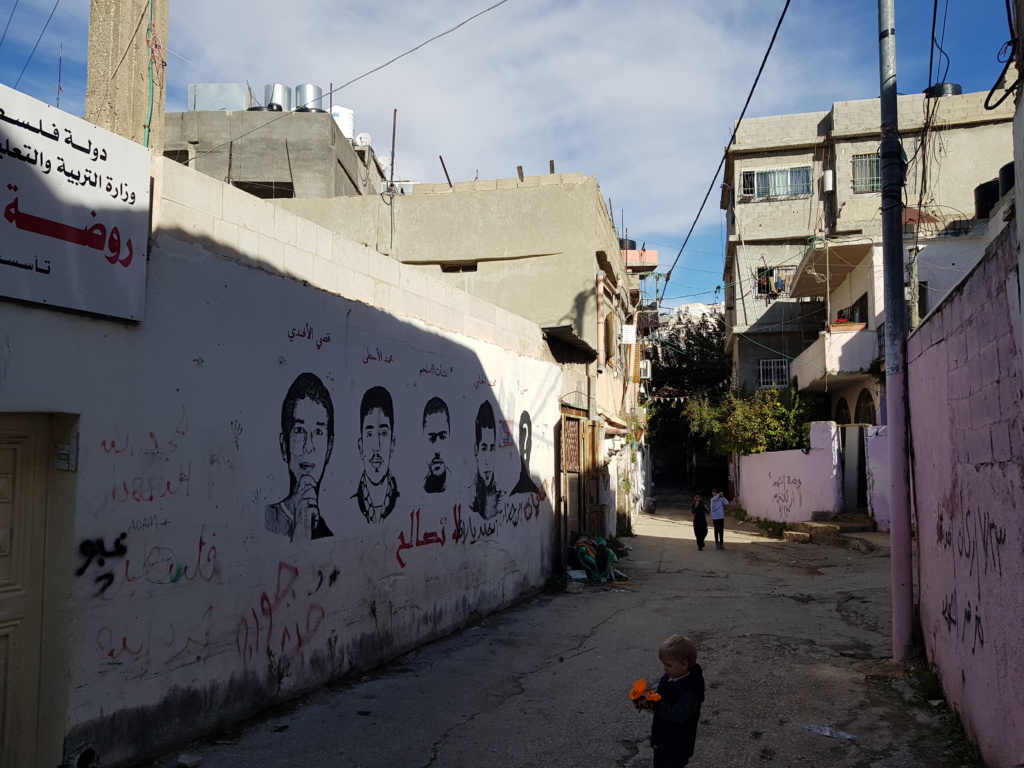
I’ve been to Aida twice now, most recently during the late afternoon last week and originally two weeks before. My first experience in Aida was earlier in the day and much longer in duration, offering me more detailed information about its history and landmarks. We saw the typical camp structures, inexpensive concrete with rough facades frequently pockmarked by bullets. Areas of recent repair or damage were pointed out to us and their stories shared. Israeli policy when entering Aida, and probably modus operandi for all the refugee camps, is to avoid walking down the tiny snaking streets and alleys. Rather, they often tunnel through buildings and homes with explosives charges, creating their own paths through the crowd of structures. It just occurred to me that it isn’t very different than their policy of Israeli-only roads, which are ever expanding through the West Bank.
Our guide told us of his daily dash for home through an area of the camp exposed to Israeli snipers when the camp was under blockade and siege during the Second Intifada and how the rush of fear and adrenaline never lessened during the crisis. The sense of relief he felt walking through unexposed alleys giving way to dread as he approached home was almost palpable as he relived it for us. It made me wonder how he manages to retell it so many times to visitors like us. I wondered if the experience had caused him to consider moving further into the cluttered interior of the camp and of how many groceries he dropped and ruined as he tried zigzagging at breakneck speed across the disjointed pavements.
Life was ruinous and difficult to imagine during the imposed martial law of the Second Intifada, but that was before the Wall. Now the Separation Wall runs along one entire side of the camp, never less than a few dozen meters from outermost line of homes and completely detaching the olive grove that used to serve the camp as one of the rare local sources of income and recreation. Every so many meters there is a guard tower, and in truth there’s only a handful along the stretch of thin, reinforced concrete dissecting Aida, but these towers lose something experienced only through printed words. They look medieval, the kind of image not of storybooks but of gritty, filthy filmed set pieces. In the twenty-first century, I might be forgiven for expecting something sleek, high tech, maybe with a gleaming chrome finish. This is the future I grew up looking forward to with so much hope for so many things that it seems infantile in retrospect. Space exploration, cures of disease, global cultural solidarity where mostly what I expected more of as a kid. I never gave much through to military occupations or security walls, but at least they could look aesthetically pleasing and sterile. In reality, they’re dirty syringes sticking needle up out of the ground, stained and grungy.
Debris, trash and litter, ever a constant in Palestine on the unseen side of walls, line the road between life and the wall. Residents would rather see a wall of trash than the towers or the wall with its depressingly impotent graffiti, but it will take many more years worth of refuse to stack high enough to eclipse 8 meters of what is a vastly shortened horizon.
My second experience in Aida took place just as the sun was setting. The view of the camp’s minaret beside a crescent moon on a cloudless blue and orange sky was simply out of place with its beauty here in this squalid slum. The mosques here are ever the finest structures in either Deheishe or Aida. They’re the antithesis of the security towers. Minarets are archaic, even pre-medieval structures and yet they are clean, geometric, orderly, and in Aida camp the minaret stands opposed to the guard towers outnumbered but refined in the face of rabble. From the roof we stood upon, you could not see them together. From there you would actually find one of the most pleasant views of Bethlehem’s urban sprawl from that rooftop, particular with the tiled minaret in the foreground. To see the tattooed Wall, the lost olive grove and encroaching Israeli settlements, you have to turn your back on both the minaret and Bethlehem. It’s a dark vision during the day, and all that much more so at night.
